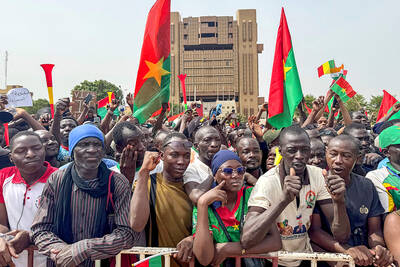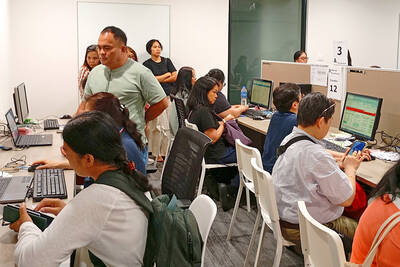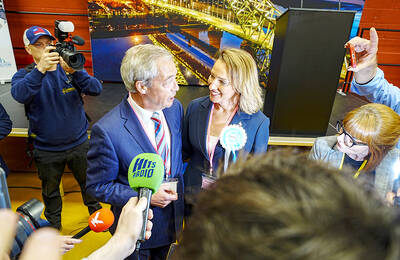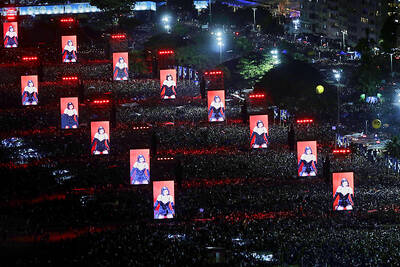Federal investigators say the government’s next generation of radiation detectors are only marginally better at detecting hidden nuclear material than monitors already at US ports, but would cost more than twice as much.
The machines are intended to prevent terrorists or criminals from smuggling into the US a nuclear bomb or its explosive components hidden in a cargo container.
The monitors now in use can detect the presence of radiation, but they cannot distinguish between threatening and nonthreatening material.
Radioactive material can be found naturally in ceramics and kitty litter, but would be of no use in making a bomb, for instance.
The US Department of Homeland Security has said the new machines it is developing can distinguish between kitty litter and dangerous radioactive material and produce fewer false alarms than the current ones.
The new machines are also better at detecting lightly shielded material.
But the machines perform at about the same level when detecting radiological and nuclear materials hidden in a lead box or casing, the most likely way a terrorist would try to sneak the materials into this country, the Government Accountability Office (GAO) said in a report to be released yesterday.
The report by Congress’ investigating agency was requested by Representative Joseph Lieberman, the Connecticut independent who is chairman of the Senate Homeland Security and Governmental Affairs Committee.
The report raises the question whether the new machines, at about US$822,000 each, are worth the cost if they’re not that much better than current ones that cost about US$308,000.
The department believes the benefits outweigh the additional cost.
But department spokeswoman Sara Kuban said on Friday the department would not comment specifically on a report that was not yet public.
She said the new machines still are being tested.
In March, Homeland Security Secretary Janet Napolitano told Lieberman’s committee that the administration was not asking for money to purchase these machines next year.
“The reason is because we were not persuaded that the technology ... the capacity of the technology that we needed, was actually there,” she said.
“Before we come to Congress and ask for more money for new technology, we needed to see something better from the science community,” Napolitano said.
For years, Congress and the GAO have been skeptical about the cost and testing of the new machines.
The new report did not criticize the department’s latest tests, but found that the results were disappointing.
The new monitors “have a limited ability to detect certain nuclear materials at anything more than light shielding levels,” the report said.
The Senate’s spending plan for the department next year calls for investing money to improve the current machines as well as hand-held radiation detectors now in use.
Because the current technology will be used for some time, “it would seem prudent to invest in this technology,” the Senate Appropriations’ homeland security subcommittee said.
The acting head of the department’s Domestic Nuclear Detection Office, Chuck Gallaway, recently told Congress that the new machines “will significantly improve our ability to correctly identify and interdict smuggled nuclear material and offer the ability to automatically sort threat materials from naturally occurring radioactive material.”

Kehinde Sanni spends his days smoothing out dents and repainting scratched bumpers in a modest autobody shop in Lagos. He has never left Nigeria, yet he speaks glowingly of Burkina Faso military leader Ibrahim Traore. “Nigeria needs someone like Ibrahim Traore of Burkina Faso. He is doing well for his country,” Sanni said. His admiration is shaped by a steady stream of viral videos, memes and social media posts — many misleading or outright false — portraying Traore as a fearless reformer who defied Western powers and reclaimed his country’s dignity. The Burkinabe strongman swept into power following a coup in September 2022

A new online voting system aimed at boosting turnout among the Philippines’ millions of overseas workers ahead of Monday’s mid-term elections has been marked by confusion and fears of disenfranchisement. Thousands of overseas Filipino workers have already cast their ballots in the race dominated by a bitter feud between President Ferdinand Marcos Jr and his impeached vice president, Sara Duterte. While official turnout figures are not yet publicly available, data from the Philippine Commission on Elections (COMELEC) showed that at least 134,000 of the 1.22 million registered overseas voters have signed up for the new online system, which opened on April 13. However,

‘FRAGMENTING’: British politics have for a long time been dominated by the Labor Party and the Tories, but polls suggest that Reform now poses a significant challenge Hard-right upstarts Reform UK snatched a parliamentary seat from British Prime Minister Keir Starmer’s Labor Party yesterday in local elections that dealt a blow to the UK’s two establishment parties. Reform, led by anti-immigrant firebrand Nigel Farage, won the by-election in Runcorn and Helsby in northwest England by just six votes, as it picked up gains in other localities, including one mayoralty. The group’s strong showing continues momentum it built up at last year’s general election and appears to confirm a trend that the UK is entering an era of multi-party politics. “For the movement, for the party it’s a very, very big

ENTERTAINMENT: Rio officials have a history of organizing massive concerts on Copacabana Beach, with Madonna’s show drawing about 1.6 million fans last year Lady Gaga on Saturday night gave a free concert in front of 2 million fans who poured onto Copacabana Beach in Rio de Janeiro for the biggest show of her career. “Tonight, we’re making history... Thank you for making history with me,” Lady Gaga told a screaming crowd. The Mother Monster, as she is known, started the show at about 10:10pm local time with her 2011 song Bloody Mary. Cries of joy rose from the tightly packed fans who sang and danced shoulder-to-shoulder on the vast stretch of sand. Concert organizers said 2.1 million people attended the show. Lady Gaga